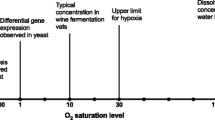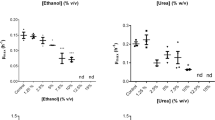Abstract
Saccharomyces cerevisiae CBS 426 was grown in continuous culture in a defined medium with a mixture of glucose and ethanol as carbon source. Growth on ethanol as the sole carbon source was only possible after the addition of a small amount of glutamic acid. The flows of glucose, ethanol, oxygen, carbon dioxide and biomass to and from the system were measured and a model for the growth of the yeast on the carbon sources constructed. The model is shown to allow independent estimation of YATP and P/O. YATP is not independent of the substrate used, but the amount of ATP used in the production of biomass from the monomers is approximately the same for growth on ethanol and on glucose.
Similar content being viewed by others
Abbreviations
- C:
-
chemical state vector
- Ci :
-
component of the chemical state vector (C-mol)
- Cx :
-
biomass present in the system (C-mol biomass)
- H2 :
-
reduction equivalents (NAD(P)H + H+ and FADH2)
- k:
-
the amount of ATP required in the production of 1 C-mol of biomass from the monomers (mol ATP/C-mol biomass)
- mATP :
-
maintenance requirement for ATP (mol ATP/C-mol biomass·h)
- P/O:
-
(=δ), efficiency of the oxidative phosphorylation (mol ATP/atom O)
- r:
-
vector of reaction rates
- ri :
-
component of the vector of reaction rates (C-mol/h)
- rATP :
-
rate of ATP production (mol ATP/h)
- rx :
-
rate of biomass production (C-mol biomass/h)
- YATP :
-
YATP growth yield on ATP (C-mol biomass/mol ATP)
- (YATP)max :
-
maximum growth yield on ATP
- α:
-
stoichiometry matrix
- δ:
-
P/O
- φ:
-
vector of the flows to the system
- φs :
-
flow of glucose to the system (C-mol glucose/h)
- φo :
-
flow of oxygen to the system (mol O2/h)
- φc :
-
flow of carbon dioxide to the system (mol CO2/h)
- φx :
-
flow of biomass to the system (C-mol biomass/h)
- φe :
-
flow of ethanol to the system (C-mol ethanol/h)
- φw :
-
flow of water produced during metabolism (mol H2O/h)
References
Dekkers, J. G. J., de Kok, H. E. and Roels, J. A. 1980. Energetics of Saccharomyces cerevisiae CBS 426: Comparison of anaerobic and aerobic glucose limitation. — Biotechnol. Bioeng. in press.
Geurts, Th. G. E., De Kok, H. E. and Roels, J. A. 1980. A quantitative description for the growth of Saccharomyces cerevisiae CBS 426 on a mixed substrate of glucose and ethanol. — Biotechnol. Bioeng. 22: 2031–2043.
De Kok, H. E. and Roels, J. A. 1980. A method for the statistical treatment of elemental and energy balances with application to steady state continuous culture growth of Saccharomyces cerevisiae CBS 426 in the respiratory region. — Biotechnol. Bioeng. 22: 1097–1104.
Mor, J. R. and Fiechter, A. 1968. Continuous cultivation of Saccharomyces cerevisiae. I. Growth on ethanol under steady state conditions. — Biotechnol. Bioeng. 10: 159–176.
Ohnishi, T., Sottocasa, G. and Ernster, L. 1966. Current approaches to the mechanism of energy-coupling in the respiratory chain. Studies with yeast mitochondria. — Bull. Soc. Chim. Biol. 48: 1189–1203.
Oura, E. 1972. Reactions leading to the formation of yeast cell material from glucose and ethanol. —Alkon Keskus Laboratorio Report 8078.
Roels, J. A. 1980. A simple model for the energetics of growth on substrates of different degree of reduction. — Biotechnol. Bioeng. 22: 33–53.
Rottenberg, H. 1979. Non-equilibrium thermodynamics of energy conversion in bioenergetics. —Biochim. Biophys. Acta 549: 225–253.
Stouthamer, A. H. and Bettenhaussen, C. 1973. Utilization of energy for growth and maintenance in continuous and bath cultures of microorganisms. A reevaluation of the method for the determination of ATP production by measuring molar growth yields. — Biochim. Biophys. Acta 301: 53–70.
Stouthamer, A. H. 1976. Yield studies in microorganisms. — Meadowfield Press Ltd, Durham.
Stouthamer, A. H. 1979. The search for correlation between theroretical and experimental growth yields. p. 28–47. In J. R. Quayle (ed.), International review of biochemistry. Microbial biochemistry. Vol. 21. — University Park Press, Baltimore.
Van der Walt, J. P. 1971. Saccharomyces uvarum Beijerinck. p. 701–707. In J. Lodder (ed.), The yeasts. A taxonomic study. 2nd. ed. — North-Holland Publ. Co., Amsterdam-London.
Yarrow, D. and Nakase, T. 1975. DNA base composition of species of the genus Saccharomyces. —Antonie van Leeuwenhoek 41: 81–88.
Author information
Authors and Affiliations
Rights and permissions
About this article
Cite this article
Bonnet, J.A.B.A.F., de Kok, H.E. & Roels, J.A. The growth of Saccharomyces cerevisiae CBS 426 on mixtures of glucose and ethanol: a model. Antonie van Leeuwenhoek 46, 565–576 (1980). https://doi.org/10.1007/BF00394012
Received:
Issue Date:
DOI: https://doi.org/10.1007/BF00394012




